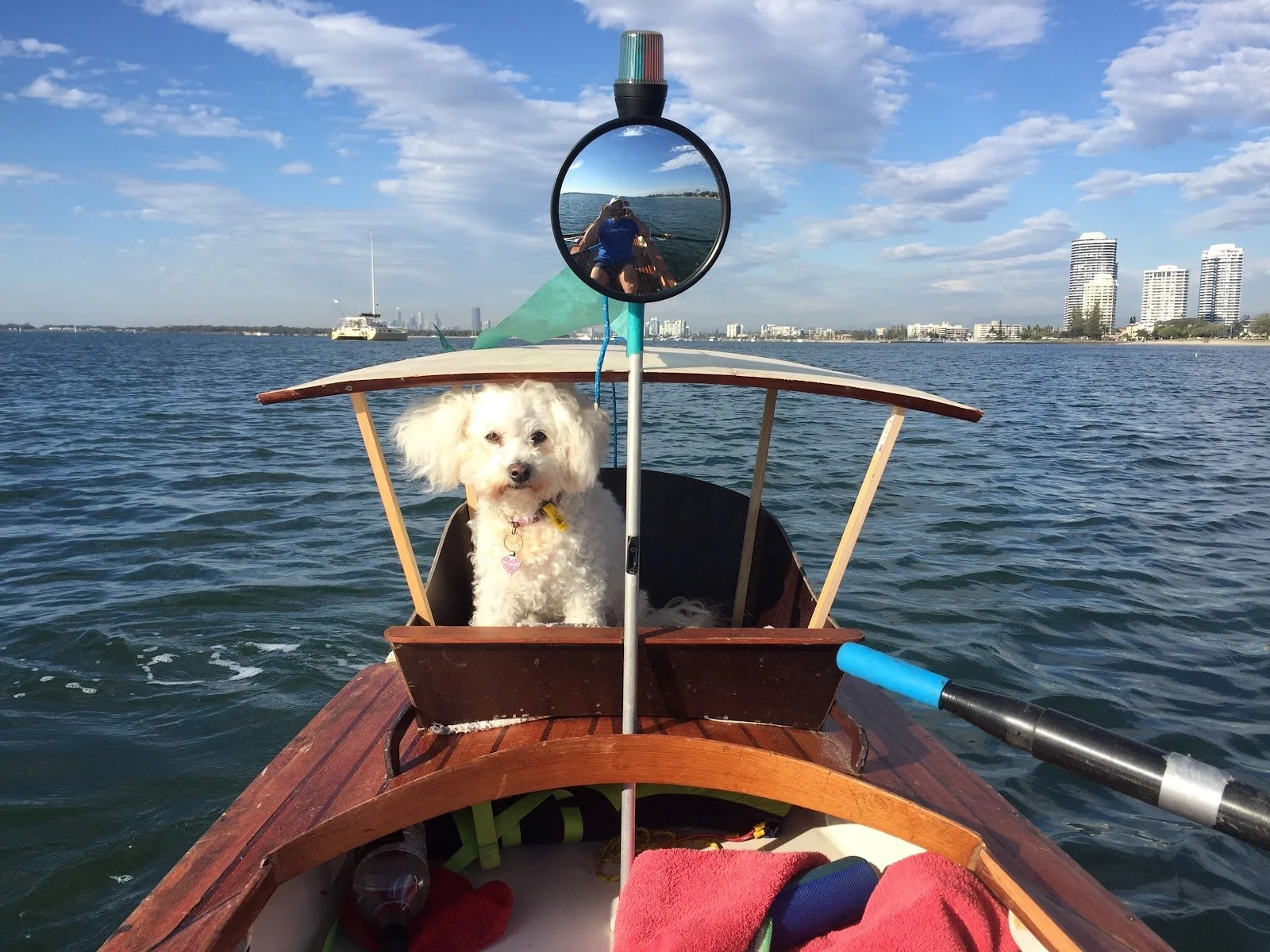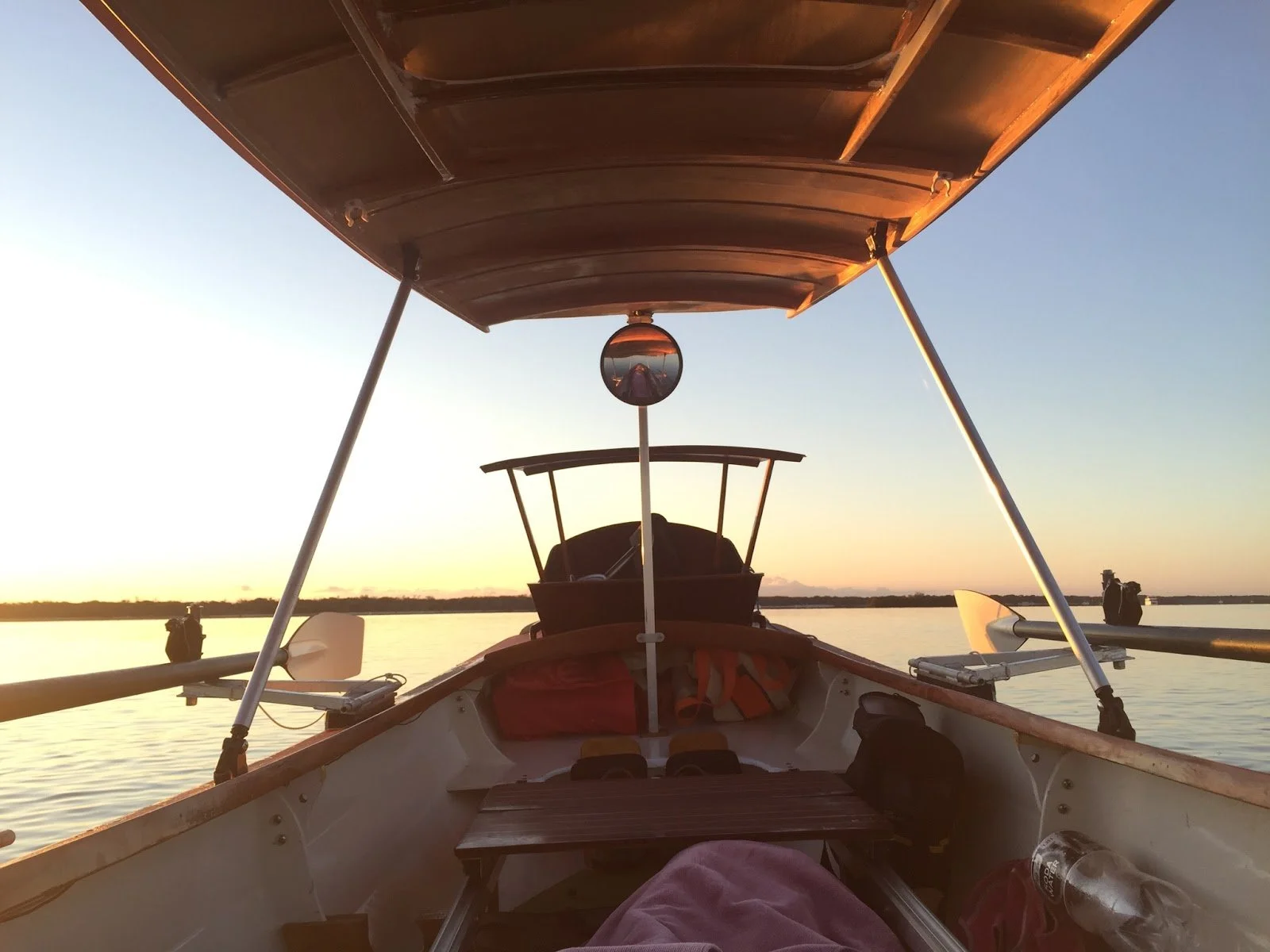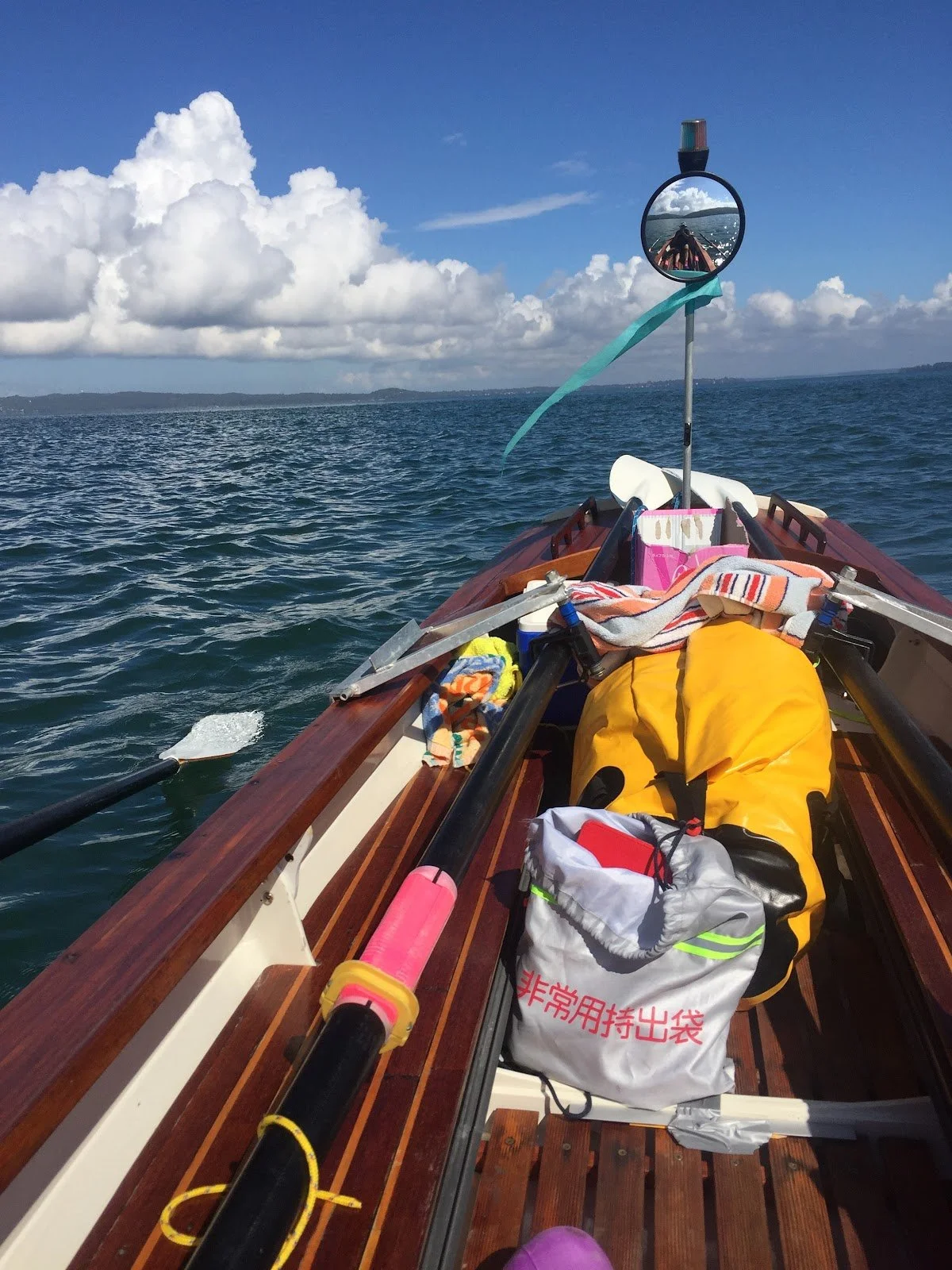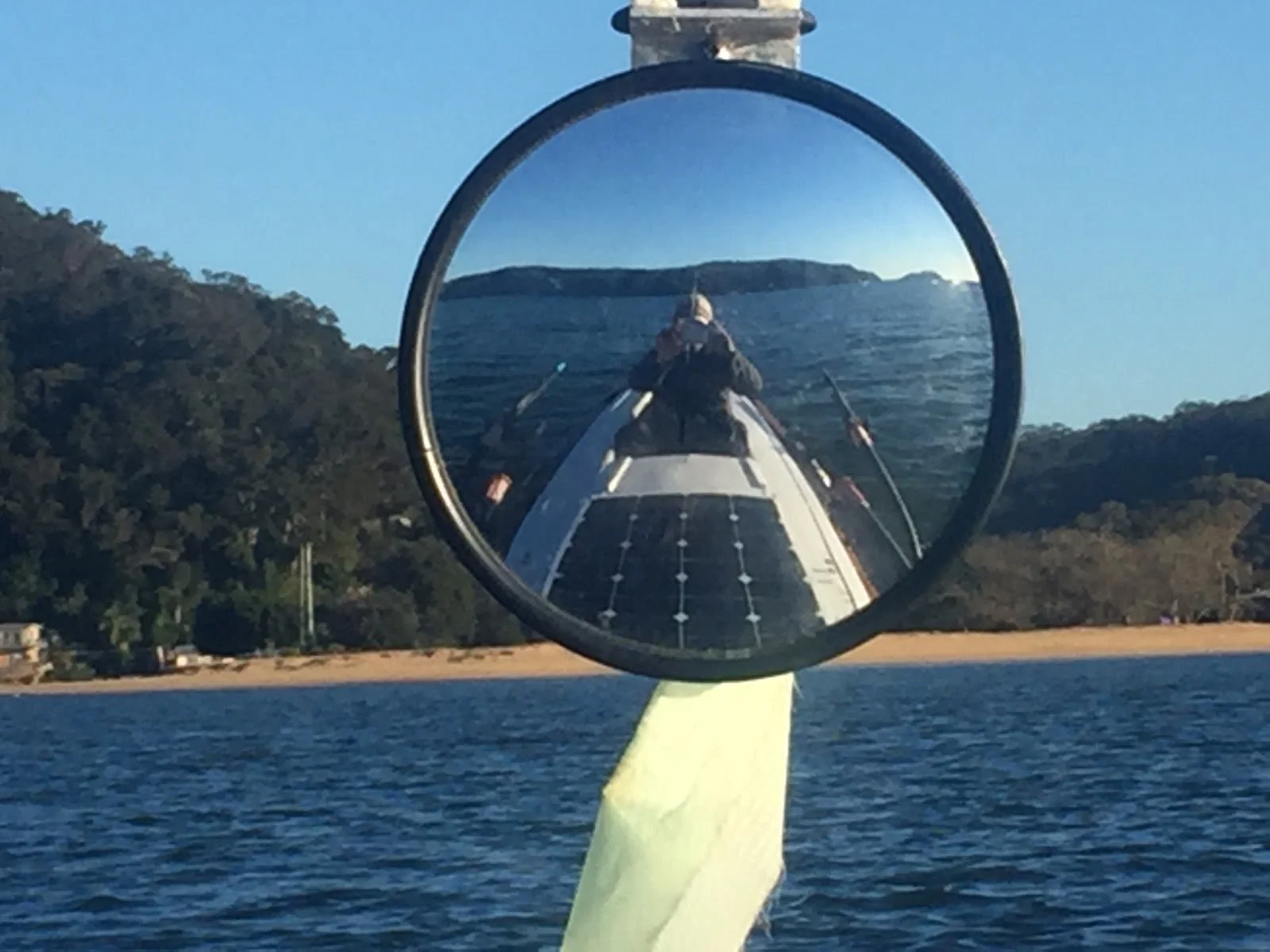Vinegar Stroke-a bicycle of the sea
by Gus Duncan
Oh No, what have I done… A ‘Pulling Boat’ called VINEGAR STROKE! If I have to explain, you probably don't want to know…
For me it’s the play of words and the visualisation of the quintessential expression of exertion... The whole of body experience that is Sliding Seat Rowing (SSR) juxtaposed with the gentle and graceful sweetness of the Whitehall design.
Perhaps someone could suggest another name better than the likes of SEAQUEST OR OCEAN MARAUDER both of which could be misconstrued… But I must say, it will be some time before I tier from the enjoyment of watching onlookers bewilderment turn to rye smiles of realisation as their synapses fire up on a time gone by ….
And to a classic boat buff, if a Whitehall’s origins were to be a guide, VINEGAR STROKE as a name is spot on, capturing the essence of their design intent. As my understand has it, their development (with probably a little embellishment) was derived from the gigs that were carried on Tall Ships that supplied America’s harbours like Boston & New York.
The story has it that there was a flotilla of similar inshore boats built to service the trading ships as Water Taxis. Firstly, these small vessels would row out and ferry the Officers ashore then load up with as much whiskey as good seamanship would allow and a parasol carrying prostitute and race back to the waiting crews to service their needs. The crews weren't allowed off the ships as they had a habit of not returning.
This need for speed lead the Whitehall's design to evolve into fast inshore boats of great renown for their ability to carry ‘precious cargo’ in all but the worst conditions.
Whitehall's have quite long waterline length for their beam, proud, upright bows and beautiful wineglass transoms that dreams are made of .... They have just the right amount of goodly displacement amidships for stability, but windage insured low slung freeboard giving them a seductive curving sheer line accentuated by their lapstrake construction.
A testimony to their usefulness and speed under human power has bestowed the honour of being called “the bicycles of the sea” by the experienced inshore men that used them.
Early Days
Vinegar Stroke off Ephraim Island, Gold Coast. Dec 2016
The kit is basically the ‘white part’ of the hull, the ‘Lid’ / roof, the decks, sliding seats and various other features like the coxswain wheelhouse for Lilly are my additions to suit daily rowing and Camp Cruising.
Lilly on watch in the wheelhouse….
Overnight aboard, Gold Coast, Australia
The kit was originally imported into Australia by someone in Manly, Brisbane. It was built by a professional boat builder for daily constitutional rowing around the canals of Manly. The build & finish was immaculate. Nicely rounded & large epoxy coves on the bulkheads & ribs. Not a scratch on it till I got it …!
Early Days…. single slider, no decks, funky navigation mirror
It had a very nicely made single sliding seat arrangement on an alloy bar that ran down the middle of the boat that made the vessel useless for anything else due to its size & position in the boat. It was one of those rigs that you would put in a skull but just didn't make much sense in a vessel of this scope.
Upon purchasing the boat I removed this apparatus and installed two side lockers with full length tracks for a sliding bench seat. A second sliding seat was added and the folding outriggers were changed to alloy for some reason which escapes me now.
I converted a Jetski trailer into a wooden, flat deck, roofed, road trailer. Although the boat sticks out both ends of the roofed trailer, the addition of some sail track & canvas covers allows the trailer to double as a garage for the boat.
Roll on roll off, Clarrie Hall Dam, Northern NSW, Mt Warning in the background
I made a beach dolly to launch & retrieve Vinegar Stroke which rolls onto the trailer, which in turn means no saltwater problems for the trailer. Launching off a beach dolly over the bank means that I'm not restricted to launching at boat ramps… And guess what, that means less stinking jet skis to contend with …
Over the bank launch at Paradise Point (EPHRAIM Island in the background)
I built side decks, a back deck & also a front deck which opens up like a trunk to a large storage compartment in what was a flotation compartment.
I still haven't replace this buoyancy but if I end you venturing offshore I promise I will. There is also a hard to reach anchor locker way up front.
The decks serve the purpose of keeping waves & rain out when rowing in heavy Arctic weather….And has made living aboard the vessel possible in conjunction with a tent.
Where's the Stout, must be in here somewhere !
Lane Cove River, The start of 10 days rowing round Sydney Harbour
The tent opened in the middle to allow getting in & out from a jetty, rafted up, or on the hard.. It had polycarbonate hoops and a line running between two masts. It flapped a lot in strong winds & was painful to put up & down. It also didn't afford any shade or shelter from showers or the sun while rowing.
This tent has been superseded by a hard roof that I call The Lid.. This Lid is generally left up for protection from the sun etc
It's actually two Lids so if it gets really windy or when rowing in big seas in Arctic regions I can drop the Big Lid & pop up through the Little Lid... although this has not been necessary. The second small Lid also makes it easier to raise & lower the larger Lid from within the boat.
It was made from the staves of an old kitchen chair and 3mm ply. The staves had just the right amount of curve.
In moderately strong wind, say 20 knots, the Lid doesn't seem to tip the vessel rowing across the wind. Wind drag is not so bad either, indicative of not needing to lower the Lid so far.
The big Lid’s down for heavy weather rowing
Breakfast in bed ..
The good thing about the Lid is that it has made rowing sooo much more enjoyable in the hot Australian sun. It can also be locked down over the deck opening to add some security when away from the boat. It's also made conversing with my rowing partners possible. Voice sound just used to disappear but now the acoustics are just great under the Lid. There are some dragonfly shower curtains held by Velcro to keep the driven rain out, canvas side covers...and fly screens yet to be made.
Until the Lid installation, there was only one mirror on the nav light mast on the rear deck which was fine when rowing two up, but a little too far away for good vision when rowing alone in the front position. But now it's possible to mount a second navigation mirror forward under the Lid where its needed to see oncoming vessels.
Crossing Port Stephens pre Lid
Augmented Rowing
Before the Lids I wanted to sail as well as row but the Lids have made this problematic. I wanted to join the ranks of countless Raiders, Inshoremen, ‘pre Moth’ canoe sailors and Camp Cruising Explorers that have gone before me. Unfortunately, in such a developed space it just wasn't going to happen. And I didn't want to loose all the advantages that have come with rowing & sleeping under a ‘hard top’.
Stowing mast, sails and lee boards when rowing while keeping sliding seat access along the whole boat, plus stowing the Lids when sailing presented me with multiple dilemmas. The increased weight of the Lids along with windage taking a knot off my ‘canter’ all served to point me to what seems to be a new frontier.
So I kept rolling around in bed, mentally rejigging everything. Until... late one night, my guide asked me a question…
“Grasshopper, where does the wind come from?”
“Why, the sun of corse ! Sails harness the resulting movements of air.”
It was only a matter of seconds and BOOM ! Another Paradigm Shift!
The Lids …solar PV panels. a sneaky electric rudder
Bingo! Augmented Rowing, A marriage made in heaven.
And so begins another aspect of Lids... “solar sailing” if you like..!
Being well acquainted with the benefits & beauty of Breast Augmentation (from a purely observational point) I could not stop thinking this new frontier should be called …Augmented Rowing...Something that is very very good made just that little bit more delightful….
Is it a slippery slope, a step too far on the dark side…? Only time & public opinion will tell… Being a sailor I know I've step over a line, but more so, being until recently, a ‘sliding seat purest’ this transgression is even more bewildering.
But I've traveled these waters before so to speak with Cycling. After years of riding like stink under my own steam I now have electric commuter bikes & soon an electric cargo bike. So in a way I have already been converted.
Now after several months of sea trials in my local waters, and recently, a week onboard VINEGAR STROKE camp cruising the Hawkesbury River & Pittwater areas near Sydney... I think it's definitely ‘A Thing’ …
Although still a work in progress, I'm ready to come out of the closet ! It works, and it works well for a first prototype. I was worried that I would row less but the opposite is happening. Conditions that would have kept me at home are no longer restrictive. My daily cruising range has increased. Previously when wind & tides contrived against me I suffered, worried or postponed. Within reason, these are not issues anymore.
I haven't tested it yet but a small row sailer, beating into ‘20something’ knots against an Augmented VINEGAR STROKE running a great circle line to said destination, or in another situation, needing to leave for home from an anchorage but becalmed… I think one can see some of the benefits of ‘augmented rowing’. If the electrics fail I can always row. A direct comparison should not be attempted, I only wish to reassure myself & others that this is not a folly.
I hacked a Torqueedo 1003 German made electric outboard motor & used their large lipo battery and remote throttle. I mounted the motor pod in a rudder so it can flip up in shallow water. It also has the ability to go unnoticed by all but the most observant or suspicious aficionados…
I hate to disappoint as VINEGAR STROKE has a following of people that run along the shores of our local passages waving in delight that someone in a sea of plastic, ‘guppy shaped’ stink boats & Jet Ski is actually rowing…. It’s a fine line indeed.
The Metrics as I understand them.
The Torqueedo 1003 has a 1000w capacity. The Lipo battery is 20ah. My cruise rowing speed with the Lids up, without Augmentation, is about 3something knots . With the motor it's about 4 something knots when set at about 100 something watts consumption.
As I slide into a stroke the consumption drops to say 60w. As I recover the stroke it goes to about 120w. I can apply as much effort as I wish. The consumption just goes down & the runtime increases to about 14something hours in this example. This kind of run time is unheard of for just trolling along as intended buy the manufacturers.
I say the motor needs me as much as I need the motor.
The speed increase over ‘naturally aspirated rowing’ might not sound worthwhile but 4kn with the Lids up and enough facilities & supplies onboard for a comfortable week away is something to behold. Five, even six knots is just another couple of hundred watts away & these speeds can be maintained daily in boisterous conditions with the right amount of feed in from the PV’s
The sailing alternative would be rowing & managing a jib & main, tacking back & forth which would be possible in only the lightest wind or a breeze from astern. Or in winder conditions, just sitting there in the hot sun staring at the sail. Augmented rowers just aim straight for Port, swing off the oars merrily, singing sea shanties all the way. It makes sense to me on so many levels.
If I punch it up to say 300/350 watts the run time comes down to 8 or 4 hours, the speed up to 5 or 6 knots. There's not much point in pushing past 350w throttle as hull speed is reached, a pressure wave is evident and only runtime is affected down to hours or minutes.
Peeking out through the canvas at dawn.
In severe conditions, with only the little Lid up I have made way in 35 knots.
In this instance the motor allowed me to control the boat with my oars. I didn't dare let it get across the breeze. A fair bit of effort & concentration was needed to just keep the oars from flying out of my hands.
The important thing was the motor took the pressure off making way. Allowing me to control the vessel. I was making 2 knots at about 150 watts. Plenty of power in reserve or hours run time at that consumption. The limiting factor with forward speed was punching through the wind waves.
Now I have to go back to the drawing board and redesign the decks, coaming & everything to handle conditions that one would not usually be rowing in. This shakedown cruise in quite windy conditions made me realise I should at least do a full capsize test in windy conditions to get the full story. That was something I wasn’t keen to do miles offshore, in our so called winter, carrying everything that I own... But it will be this summer.
Just to be sure … no Lids, 30kn Westerlies crosswind predicted
The big difference is ...against any reasonable current or wind with the Lids up in all their glory, I will still be able to cruise comfortably with a moderate elevated heart rate for hours using only about 150w maybe 200w which is replaced by the Solar Panel on way, or if not, when having a cup of tea in the galley…
Tell me it's not wrong …






























